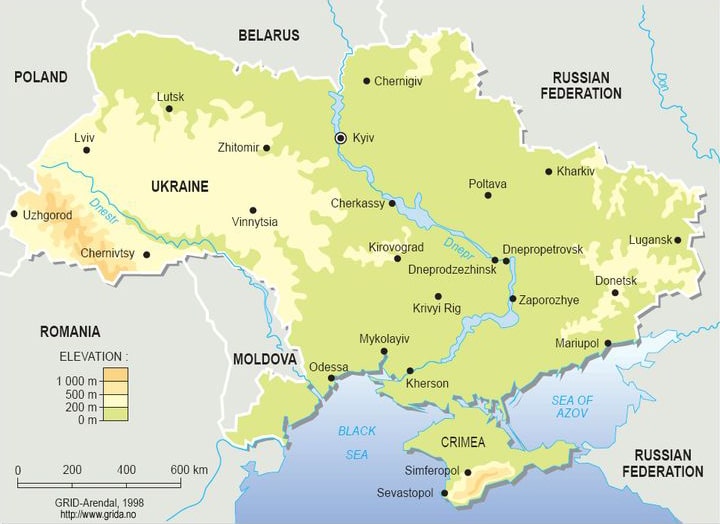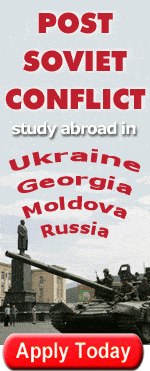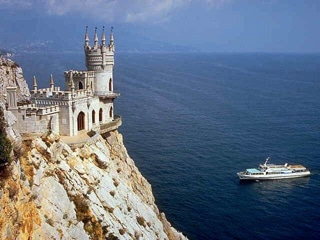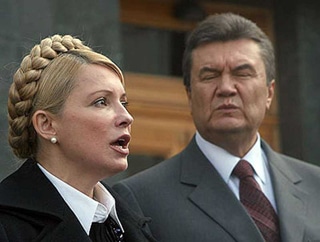Ukraine is no longer “The Ukraine.” For centuries, the definite article was considered appropriate, given the land’s history and the name’s meaning. However, given recent events, the article is usually considered inappropriate, and even offensive.

Topographic map of Ukraine with major cities shown. Crimea is now disputed territory de facto controlled by Russia.
The Dnepr River, a broad and easily navigable river that flows through the heart of modern Ukraine, was first settled by humans as the Ice Age receded around 5000 BC. The settlers raised crops and livestock there, and are sometimes credited as the world’s first equestrians. They interacted with other peoples from as far away as Central Asia, the Middle East, and Scandinavia, including with the Scythians, the Samaritans, the Khazars, the Ostrogoths, and the Hellenic Jews.
By the sixth century, this mixing of peoples produced a new distinct linguistic and cultural group, known as the Slavs, who set about building fortifications and militaries to protect themselves. However, while their land held rich potential, including Europe’s richest farming ground and its most profitable trade route, they remained plagued by invasions and infighting.

Rus’, like most of the land to its east, fell to the Mongols as the Hordes spread through Asia and into Europe. In the mid 14th century, Mindaguas of Lithuania conquered eastern Ukraine (including Kiev) from the Mongols, while western Ukraine was absorbed into an expanding Polish empire. The two halves were united when the Lithuanian and Polish empires did the same in the 16th century to present a united front against an increasingly aggressive and newly independent Moscow. By this time, the local people around the Dnepr were known as “Ruthenians.” They worshiped in Orthodox churches and spoke a language also called “Ruthenian.” These locals did not fare well in the new Latin-speaking, Catholic empire, and were soon relegated to serfdom, producing grain for the profit of the Polish nobility.
Many fled south to the Central Dnepr Basin. This area was a block of fertile land contested between the Poles, the Turks, and the Tartars of Crimea, but over which no one held effective authority. It was known as the “U-krayi-na,” or “The Borderlands,” due to its location at the edge of these empires. The fiercely independent Ruthenians became master equestrians and warriors to protect their new independence from all three potential masters. Their loose militia system, which allowed them to spend most of their time farming, but strongly banded them together in war, was so effective that the rebuked Turks soon began referring to the warrior-farmers as “Cossacks,” or “free men.”
For the first time in their history, natives of Ukraine had become a truly independent entity, and not a borderland for another civilization. Europe’s poor and oppressed flocked to them, hoping for a better life, and soon the Cossacks were powerful enough to sack Constantinople, crush Poland, and, under the legendary hetman Bohdan Khmelnytsky, to establish an independent country covering much of modern Ukraine.
This independent Ukraine would last only three years. Khmelnytsky, seeking military support from Moscow to help sustain his new country from a continued Polish threat, would sign the Treaty of Pereyaslav in 1630. The actual document is now lost to history, and what, exactly, it contained is a source of contention among historians. Some insist that Khmelnytsky only agreed that his country would be an independent protectorate of the Russian empire. Others insist that the document empowered Russia to fully absorb the lands claimed by Khmelnytsky into the Russian empire. Some concede that Khmelnytsky pledged loyalty to the tsar, but insist that he was tricked into doing it. Whatever the document actually stated, the tsar soon claimed dominion over the land.
In the 19th century, Ukraine was drawn in half again, with eastern Ukraine absorbed by the Austro-Hungarians after a treaty was signed with Russia. Both empires instituted a particularly harsh form of serfdom in Ukraine, just as most of Europe was moving towards freer social forms. It was at this time that Ukrainian nationalism was born. Scholars at the university in Kharkiv began studying and documenting local customs, songs, stories, and the local language, which began to be referred to as “Ukrainian” rather than “Ruthenian.” In 1840, Taras Shevchenko published Kobzar, a collection of Ukrainian poetry that is still considered the greatest achievement of that written language. Yet the peasants who owned the culture and language remained a lower class, and many immigrated at this time to new lands of freedom: America and Canada.
During WWI and the Russian Revolution of 1917, Ukraine shifted between governments led 
Under the Soviets, Ukrainians, like most of the minority peoples of the USSR, would see dramatic and sudden shifts in the national policies that affected them. While at times, their culture and language would be celebrated and supported, at other times it would be suppressed and discouraged. Ukraine did not fare well under Stalin’s purges, and was particularly stricken by the Soviet’s collectivization programs, which many in Ukraine blame for the famine of 1932-1933. For many, this “Holodomor,” a word that translates to “murder by starvation,” was a focused attack on the Ukrainian people by the Soviets.
The country would remain divided until the USSR “liberated” the western half in WWII, which saw the Nazis ravage the area and decimate the centuries-old, economically and culturally vibrant Jewish population. Many Ukrainians in both the east and west of the country resented the Soviets as much as any of the previous occupiers.
The Soviets, however, also carried out highly effective industrialization programs, expanded social services and education, invested in substantial infrastructure projects, and provided the stability for a particularly significant period of economic development for the region.
Post-Soviet Ukraine
“The Ukraine” became simply “Ukraine” again only in 1991, when the Soviet Union fell. Since independence, Ukraine has stood out among the former Soviet republics as a relatively stable democracy. However, modern Ukraine faces a number of pressing political and economic problems, most of which can be traced back to its complex history.
The country’s east is very different from its west. In western Ukraine, where the European powers of Poland and Lithuania were long dominant, the population is more likely to speak Ukrainian (a language with significant Polish borrowings), and to desire greater integration with the European Union. Those in the east are more likely to speak Russian, and see Russia as Ukraine’s most important partner. This east-west split has manifested itself in debates on whether to make Russian an official language of Ukraine, and in legislation that has restricted the use of Russian in schools, government, and even on TV and at the cinema. The split has also meant that Ukraine’s leaders have had to carefully balance their foreign policy, actively developing relations with the EU and Russia, while being careful not to favor any one side too greatly.

The Crimean Peninsula, which lies on coast of the black sea has long been a popular tourist destination known for its spas, hot springs, and wine making.
The Crimean Peninsula represents another division. The area is still home to fiercely independent Cossacks who maintain a significant independence movement. Some nationalist Russians also argue that the Soviet-era transfer of the Crimea from the Russian SSR to the Ukrainian SSR was illegal, and therefore the peninsula should be returned to Russia. The presence of a Russian naval base in the Crimean city of Sevastopol has also complicated the situation, both in terms of facilitating increased Russian influence there and exacerbating Ukraine’s internal divisions. Supporters of the base, mostly in the east, argue that its presence increases Ukraine’s security, and that the rent Russia pays for the base is badly needed by the national treasury. Detractors, mostly in the west, point to the provision in Ukraine’s constitution that forbids foreign military bases on Ukrainian soil.
In several post-Soviet countries, these types of cultural and ethnic divisions have resulted in civil war and armed conflict. While Ukraine has avoided this fate, it has not been without political drama. In 2004, the candidate backed by Russia, Viktor Yanukovych, was declared the winner of the Ukrainian presidential elections. Claiming widespread vote-rigging, protestors swept Ukraine’s major cities in what has become known as the “Orange Revolution.” In Kiev alone a 500,000-strong demonstration was held. The government had no choice but to hold a new round of elections immediately. Orange Revolution leader Viktor Yushchenko won with 52% of the vote.
Yushchenko ran on a largely liberal platform that favored European and NATO integration and a protected status for the Ukrainian language. Many say that Russia’s secret service played a role in Yushchenko’s dioxin poisoning during the election, which left his face badly scarred. While his term in office began with much international fanfare, his government was unable to unite the country’s various political interests. The government was also badly internally divided; Yushchenko clashed with his fiery prime minister and one-time Orange Revolution ally, Yulia Tymoshenko.

A political map of Ukraine showing the results of the 2010 presidential elections. Support for the pro-Russian Yanukovych is shown in shades of blue while the pro-European Tymoshenko is shown in shades of red. Ukraine has historically been divided between empires along the Dneper river. This division can today still be seen in the country’s linguistic and political cultures.
In an effort to improve citizens’ lives and inject much-needed investment into Ukraine, Yushchenko pushed for significantly increased state spending. However, he was not able to strengthen Ukrainian institutions well enough to improve tax collection and fight corruption, which meant that public debt surged and, especially after the onset of the global financial crisis, Ukraine soon had considerable problems meeting its internal and external financial obligations.
To make matters worse, the Ukrainian economy was also threatened at this time by the loss of subsidized gas from Russia. While all former Soviet states had once paid Russian domestic prices for natural gas, Russia has since been renegotiating prices. Ukraine’s industry, from its steel and power plants to its chemicals factories, are all dependent on natural gas to run, and Russia supplies the vast majority of Ukraine’s natural gas. Thus, when Russia requested a nearly four-fold increase in prices, Ukraine was hard hit by economic uncertainty.
Several international incidents occurred, which have become collectively known as the “gas wars.” Ukraine had long paid for most of its gas by using the pipeline system it controls to transport Russian gas to lucrative Western European markets. When Russia insisted that the process be monetized and the value of the gas raised, Ukraine resisted. On more than one occasion, Russia has cut off supplies to Ukraine for non-payment. According to Russia, Ukraine then used the fact that Russian gas was still flowing through its territory to illegally siphon gas. As a result, Russia’s European customers complained of decreased supply, and in 2009, even had scramble to find other sources of gas during an exceptionally cold winter.
These disagreements were largely solved in 2010 by an agreement between Russia and Ukraine to reduce the price of gas by 30% off “market prices” in exchange for Ukraine granting Russia an extended lease on the controversial Sevastopol naval base. Ukraine’s position in renegotiating its price was also severely limited by the inauguration of the Nord Stream pipeline in 2011. The new pipeline allows Russia to transport natural gas directly to Germany via the Baltic Sea. Russia now openly states that it is rerouting much of its gas transit to Nord Stream in an effort to bypass its troublesome Eastern European partners and better serve its Western European customers.
Today’s Ukraine

Yulia Tymoshekno, left in traditional Ukrainian braids, is of Russian decent but is a moderate Ukrainian nationalist. She commands a political minority and a near-cult like following in Ukraine. She has been accused by Viktor Yushchenko, right, of abusing her office while she served as Ukraine’s prime minister from 2007-2010.
The 2010 agreement was in part facilitated by the 2010 presidential elections, which saw Yushchenko voted out of office and replaced, perhaps ironically, by Viktor Yanukovych, who, this time, won what was roundly seen as a free and fair election. As in the 2004 elections, Yanukovych saw strong support from Ukraine’s rural areas and its eastern cities.
Viktor Yushchenko, who came in fifth place in the 2010 elections with a humiliating 5.5%, has now largely disappeared from state politics. Yanukovych has worked to quickly consolidate power around himself, appointing one of his main rivals, Sergei Tigipko, as a vice prime minister, and imprisoning Yulia Tymoshenko for alleged abuse of office for “working against the interests of Ukraine” by agreeing to buy gas from Russia in 2009 at what were alleged to be “inflated prices.”
Many thought that this was a temporary move by the Yanukovych administration to gain traction in further negotiations with the Russians. However, she remains imprisoned, and the government is now seeking to introduce new corruption charges against her. Her imprisonment has become an international incident, with Tymoshenko’s daughter personally working to gain political help in Washington DC, and the EU threatening to cut financial assistance to Ukraine.
Economically, Ukraine is still struggling. As the largest country on the European continent, its potential as an agricultural and industrial producer, as well as a transport corridor, are great, but unrealized. Despite economic growth of over 5% per year from 2000-2008, Ukraine still relies heavily on Soviet-era infrastructure. Investment remains stunted by corruption, weak government institutions, and political uncertainty.
One particularly bright spot for Ukraine is its growing service and technology sectors. These are being driven by the abnormally high numbers of Ukrainians who pursue and complete a higher education. Thus, Ukraine has become a global hotspot for outsourcing IT and engineering. While many of Ukraine’s best young minds seek their economic fortunes abroad, those that stay at home are also increasingly seen as the country’s best bet to improve its government and strengthen its civil society, which will be a major step towards securing real economic development and improving the lives of all Ukrainians.
Flat and highly fertile, Ukraine was historically a divided and occupied territory. Even after its independence, it remains a heterogeneous mix of often conflicting peoples, languages, politics, and foreign policy interests. Yet, despite these pressures, Ukraine has avoided the history of civil war and armed conflict that has befallen other former Soviet states. To the student of domestic or foreign policy, history, or culture, Ukraine provides a fascinating case study.
Find Out More About Programs in Kiev, Ukraine


